There are 9 species of native turtles in Nebraska, including a variety from Box turtles to map turtles, to snappers and more. The state has several major rivers, plenty of streams, ponds, and other watery habitats, Nebraska really has everything turtles need to thrive. There are also plenty of open prairies and lush grasslands for terrestrial turtles.
Here in Nebraska, you will find turtles that spend most of their time in water, like the Common Snapping turtle, as well as mostly land dwelling turtles such as the Ornate Box turtle.
While you are out and about in this midwestern state, keep your eyes peeled and you might see these 9 species of turtles:
Table of Contents
Turtles in Nebraska
1. Blanding’s Turtle

- Experience Level: Intermediate
- Family: Emydidae
- Scientific Name: Emydoidea blandingii
- Other Names: N/A
- Adult Size: 5 to 8 inches (12.5 to 20 cm)
- Life Span: Up to 80 years
- Average Price Range: $300 to $450
- Conservation Status: Endangered
Our first turtle on the list is somewhat of an old-timer. Blanding’s turtles have dark colored, nearly black carapaces (upper section of the shell) with small, yellow dots. The most striking feature that you can see from a distance away is the bright yellow chin and throat.
The rest of their skin is black on the limbs, and yellowish closer to the shell. The plastron is yellow with various black patches.
These turtles are amazing because they don’t seem to age, at least they don’t compared to most other animals on the planet. Blanding’s turtles can live over 80 years, and still mate, and lay eggs well into these late years.
Blanding’s turtles like to live in bogs and marshes, or streams and other permanent bodies of water with lush vegetation. They spend plenty of time in the water, but will also travel long distances on land between watery habitats.
Omnivores by nature, these turtles feed on crayfish, mollusks, worms, insects, and other invertebrates. They will also munch on plants such as duckweed and other aquatic veggies.
Box Turtles in Nebraska
2. Ornate Box Turtle
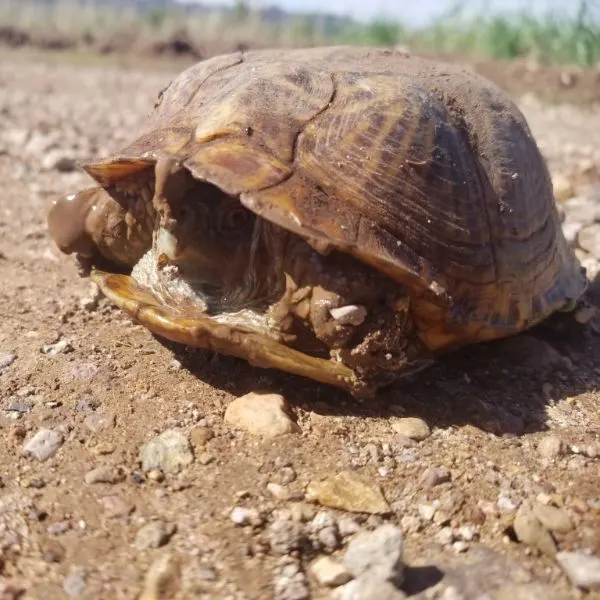
- Experience Level: Intermediate to Expert
- Family: Emydidae
- Scientific Name: Terrapine ornata
- Other Names: Box Tortoise, Western Box Turtle
- Adult Size: 4 to 5 inches
- Life Span: 30 to 40 years
- Average Price Range: $150 to $450
- Conservation Status: Near threatened
Next up is the only terrestrial turtle native to Nebraska, the Ornate Box turtle. These turtles can close themselves into their shell completely, like a box. I wouldn’t stick my fingers too close to this turtle because even if they don’t bite, you could get your digit pinched between the shells.
Ornate Box turtles can swim fairly well, but they prefer to live in grasslands, prairies, and along the edge of some forests. They will soak in puddles and shallow waters when the heat gets too much, but most of the time they wander among the grasses and underbrush of Nebraska.
Their domed carapace is dark brown or nearly black with yellow or orange spots and stripes on the scutes. Scutes are the individual plates or growth sections on a turtle’s shell. They have dark colored skin with yellow or orange spots and patches making these turtles very popular among collectors.
Though they are active during the day, they often spend time basking or hiding away except after rainfall. When a soaking shower has passed through, these turtles really become active. They will roam about searching for worms, insects, and other things to eat. They are omnivorous so they will eat plants, berries, fruits, carrion, mushrooms, and invertebrates.
Map Turtles in Nebraska
3. False Map Turtle
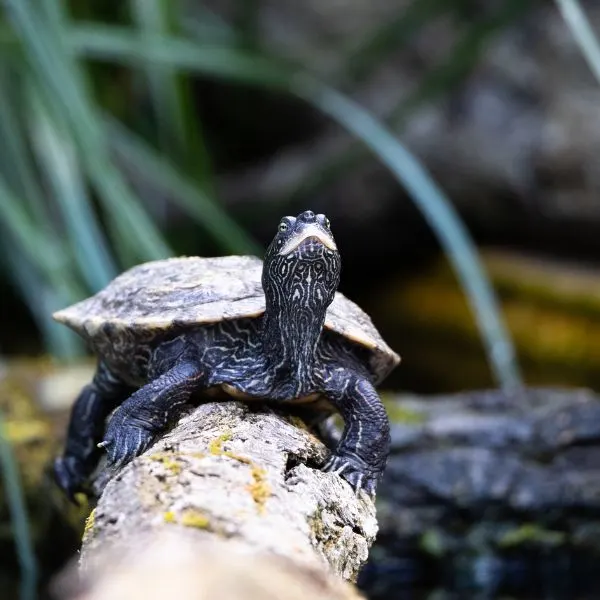
- Experience Level: Beginner
- Family: Emydidae
- Scientific Name: Graptemys pseudogeographica
- Other Names: Sawback turtle
- Adult Size: 3.5 to 10.5 inches
- Life Span: 30 to 50 years
- Average Price Range: $6 to $40
- Conservation Status: Least concern
False Map turtles have green, olive, or dark brown carapaces. When they are young you can see orange swirls, stripes, and markings that resemble relief map contours on their shells, leading to their names. I’m not sure why they are called “false” turtles though, but I wouldn’t rely on their shells to navigate.
You may see a dark ridge running down the middle of the upper shell, and saw-toothed serrations at the back of the shell. Though these distinctions smooth out as the turtle reaches adulthood.
They have an abundant amount of stripes on their head, neck, and limbs. Most times, False Map turtles have a yellow or white stripe behind their eyes that looks like an inverted L.
In Nebraska, False Map turtles are rare, but they can sometimes be found in large bodies of water such as lakes, tributaries, and reservoirs. They really look for ample basking sites like fallen logs and sandy banks, because they spend a lot of time soaking up the sun’s rays.
Map turtles are omnivores that will feed on crustaceans such as mussels, clams, and crayfish, as well as insects, mollusks, and vegetation.
Mud Turtles in Nebraska
4. Yellow Mud Turtle
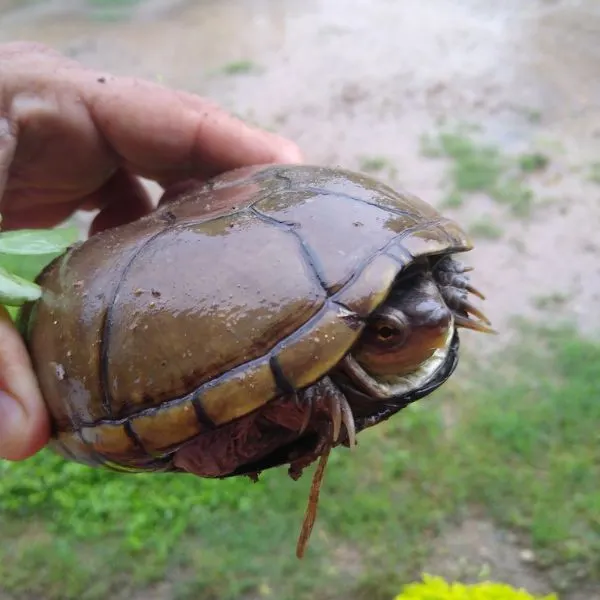
- Experience level: Intermediate
- Family: Kinosternidae
- Scientific Name: Kinosternon flavescens
- Common Name: Mud Turtle, Yellow Mud Turtle
- Average Adult Size: 5 – 7 inches
- Life Span: 40 years
- Average Price Range: Approximately $80 to $300
- Conservation Status: Conservation Status: Federally listed as least concern, but threatened or endangered in most states.
Now let’s find out about the Yellow Mud Turtle. These turtles dwell in grassy marshes, ponds, lakes, rivers, and nearly any permanent or temporary body of water. They like muddy or sandy areas so they can burrow in the summer and winter, but this mud turtle also can be found in grasslands.
These small turtles have a yellowish-brown, or dark brown, domed carapace with a flattened top. They have dual hinged shells and are the only turtle in Nebraska with this distinction.
Mud turtles took a clue from musk turtles and have glands that can release a greasy stench if they are threatened. You might want to wear gloves before handling these little stinkers.
The skin on the turtles can be dark green, brown, or pale yellow. They also have small, fleshy barbels under their chins.
Yellow Mud turtles are mostly carnivorous and will eat snails, crustaceans, fish, earthworms, tadpoles, and leeches.
Painted Turtles in Nebraska
5. Western Painted Turtle

- Experience Level: Beginner
- Family: Emydidae
- Scientific Name: Chrysemys Picta Belli
- Other Names: N/A
- Adult Size: Between 4 and 10 inches
- Life Span: Between 30 and 50 years
- Average Price Range: Between $30 and $150
- Conservation Status: Least concern
Painted turtles are the most widespread type of turtle in the United States. The Western Painted turtle is the largest of the subspecies and is found across Nebraska.
All painted turtles have dark brown to black skin and yellow, white, or reddish orange stripes. What sets the Western Painted turtle apart from the others, aside from the size is the plastron. Though in the wild, you’ll probably never see their belly, this subspecies has a bright orange or red plastron with a dark and colorful pattern along the midline.
These turtles are not picky when it comes to habitats. They will inhabit any type of waterway in the state, and they are the first ones to come out of hibernation. These turtles emerge in March and start basking on logs, banks, or other areas out of the water.
Juvenile Painted turtles feed mostly on insect larvae and spiders, while adults vary their diet more. Adult Western Painted turtles feed on crayfish, insects, fish, tadpoles, and plants, though vegetation makes up a big part of their diet.
Pond Sliders in Nebraska
6. Red Eared Slider
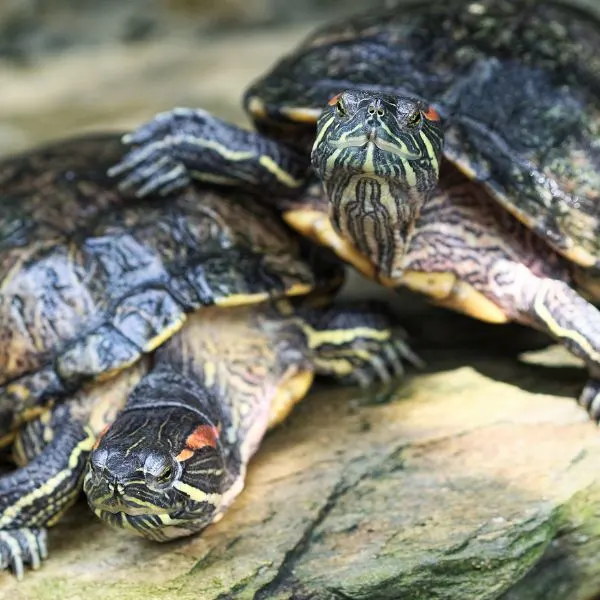
- Experience level: Beginner
- Family: Emydidae
- Scientific Name: Trachemys scripta elegans
- Common Name: Pond slider, Red-eared terrapin, Water slider
- Average Adult Size: 6 – 8 inches
- Life Span: 20 to 40 years
- Average Price Range: approximately $30 to $100
- Conservation Status: Least concern
Our next turtle you can find in Nebraska may be more popular than you know. Do you remember the cartoon, comic books, video games, action figures, several movies, etc about a certain set of turtles? The Teenage Mutant Ninja Turtles were Red Eared Sliders!
Once super popular in the 1940s and 1950s, they faded in popularity until the Ninja Turtles caused another surge in the 1990s. While Nebraska Red Eared Sliders aren’t going to pop out of the sewers looking for pizza, you might find them in a few counties in slow moving waters.
Red Eared Sliders have brightly colored shells, dark skin and scales, and yellow or white stripes along their extremities. They also have red patches behind their eyes that give them their names.
These turtles like to bask, and will often crowd basking areas and climb on top of each other to get the best spot. These turtles are omnivores that will feed on fish, crayfish, tadpoles, insects, and other small aquatic wildlife. They also eat a wide variety of plant matter.
Snapping Turtles in Nebraska
7. Common Snapping Turtle
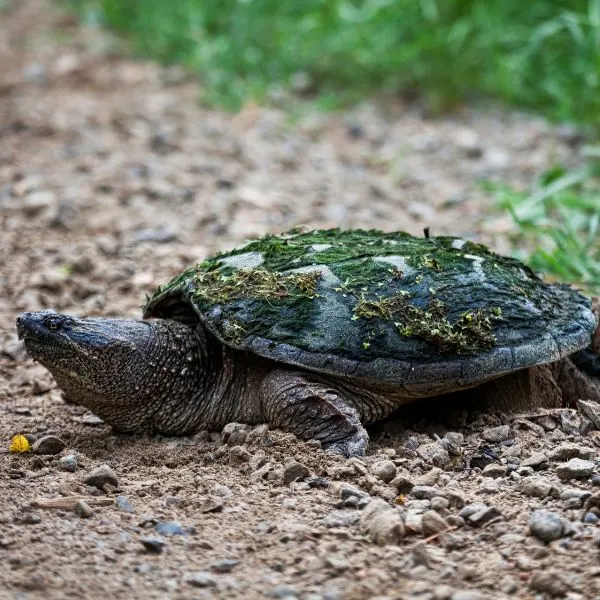
- Experience level: Intermediate to Expert
- Family: Chelydrida
- Scientific Name: Chelydra Serpentina
- Other Names: Snapping Turtle, Snapper, Eastern Snapping Turtle
- Average Adult Size: 8 to 20 inches
- Life Span: 30 – 50 years
- Average Price Range: Approximately $40 to $120
- Conservation Status: Least concern
Now we come to the largest turtle found in the Cornhusker State, the Common Snapping turtle. These turtles can exceed 19 inches in carapace length, and weigh over 35 pounds. That’s a beefy turtle!
You’ll recognize these big turtles by their dark colored shell, long, muscular limbs, and very long tails. The skin on these turtles ranges from a dark yellow to dark brown and is covered in lumps and fleshy spikes. The plastron on these turtles is very small and white or pale cream colored.
The Snapping turtle has a long neck and a broad head with a sharp beaked mouth, but they don’t like to use it on people unless they are cornered and out of the water.
They have a reputation for being aggressive, but it’s because they are scared. As long as you leave them alone and give them space, they won’t mess with you.
Common Snapping turtles are very aquatic turtles that don’t leave the water often. Even when they bask, it’s usually only at the surface of the water. Females will leave to find a nesting site and will travel long distances.
Lakes, rivers, reservoirs, and permanent ponds often host Snapping turtles.
Mostly carnivorous, Snapping turtles will eat nearly anything they can get in their big mouths. This includes fish, frogs, tadpoles, small turtles, and rarely small water birds. They also feed on vegetation and algae.
Softshell Turtles in Nebraska
8. Midland Smooth Softshell

- Experience level: Intermediate
- Family: Trionychidae
- Scientific Name: Apalone Mutica
- Other Names: N/A
- Average Adult Size: 5 – 14 inches
- Life Span: 10 – 20 years
- Average Price Range: $50 – $150
- Conservation Status: Least Concern
Our first Softshell turtle is the Midland Smooth Softshell species. These flattened turtles don’t have a hardened shell made of keratin, instead, it is made of cartilaginous plates covered in a leathery skin. In fact, sometimes you can see part of the spine and ribs through the carapace.
The upper shells on these turtles are mostly sandy brown, grey, or darker brown with black spots or circles. The skin on Midland Smooth Softshell turtles is usually the same color as the upper shell. They have elongated heads and snouts with lighter colored stripes bordered by black.
Since they don’t have much protection in the form of a hard shell, they have sharp claws, and a powerful bite for defense. Softshell turtles are also the fastest turtles on land. You might be surprised when you see them take off toward the water.
The Midland Smooth Softshell turtle prefers large bodies of water with sandy bottoms. They like the feeling of sand between their toes so much that they will usually bask on sandy banks instead of fallen logs and rocks.
The soft, sandy bottom serves a dual purpose as these turtles like to bury themselves in the sand and ambush prey that swims by. These turtles are carnivores that eat fish, tadpoles, mollusks, crayfish, and other aquatic animals.
9. Spiny Softshell Turtle

- Experience Level: Intermediate to Expert
- Family: Trionychidae
- Scientific Name: Apalone spinifera
- Other Names: N/A
- Adult Size: 5 to 9 ½ inches for males, 10 to 17 inches for females
- Life Span: Between 20 and 50 years
- Average Price Range: Between $20 and $120
- Conservation Status: Threatened in some areas
The last Nebraskan turtle on our list is the Spiny Softshell turtle. These turtles look much like the Midland Smooth Softshell, except for the fleshy spikes and bumps along the front ridge of the shell. The leathery carapace also feels a little like sandpaper on this turtle, compared to the smooth feel of the Midland.
Like most other Softshell turtles, females of this breed grow nearly twice as big as the males.
Spiny Softshell turtles aren’t as particular about sandy bottoms. As long as the substrate isn’t predominantly gravelly or rocky, these turtles can be found in the water. They also tend to favor waters with strong currents but can be found in still ponds, lakes, and reservoirs.
Again, these turtles are carnivorous, preferring to eat fish, crustaceans, insects, aquatic organisms, and carrion.
FAQs
Where do turtles go in the winter in Nebraska?
Turtles in Nebraska hibernate or brumate through the winter. Brumation is like hibernation, except the animal is still slightly active. Some turtles in Nebraska spend the winters at the bottom of the water or buried in mud. They will come up for air occasionally, but their functions slow down so much that they don’t have to surface often.
Wrapping up
You just met the 9 species of turtles found in Nebraska. Have you seen them all in their wild habitats? Are you ready to go out and try to find them, or are you thinking of getting one of these as a pet? If you are, be sure to find a licensed, respectable breeder who can give you all the information you need before making a decision.
We hope you enjoyed this list. If you did, go ahead and leave us a comment below. We love to hear from our readers and other reptile enthusiasts.
Other nearby states
